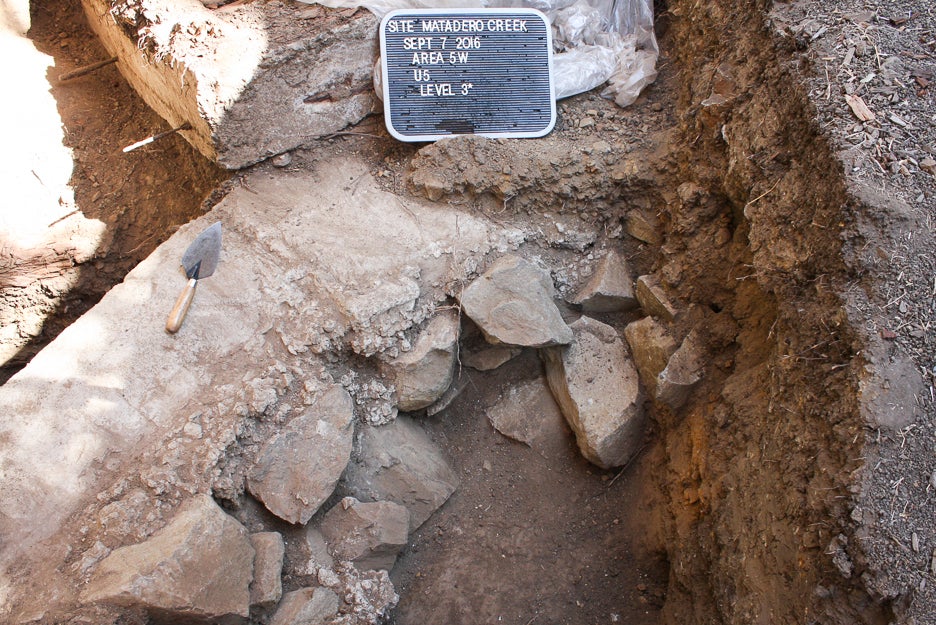
University biologists and archaeologists working to improve the lives of threatened species recently discovered remnants of a long-forgotten jail. (Image credit: Courtesy Laura Jones)
University biologists and archaeologists working to improve the habitat of threatened species on university lands have rediscovered a long-forgotten jail located off Old Page Mill Road.
In the early 1900s, the jail housed up to 28 county prisoners in a substantial concrete building whose footings and steps have been uncovered during recent archaeological digs. The prisoners’ punishment included mining basalt from a handful of quarries in the Stanford foothills to be used for paving roads, including El Camino Real.
The rediscovery of the jail surprised even university archeologist Laura Jones, whose 23-year career at Stanford has brought her to nearly every corner of the university’s lands.
But one of the best parts of the story is that it all begins with a frog.
Land-use mystery
Under the provisions of Stanford’s Habitat Conservation Plan, implemented in 2010, university biologists work to monitor and enhance the habitats of threatened species living on Stanford lands. Biologists were conducting annual monitoring and investigating the possibility of creating wetlands favored by the threatened California red-legged frog living along Matadero Creek. While doing so, they found debris that was clearly the result of previous human use of the site. That discovery spurred an investigation into the area’s history by Jones and her staff.
They turned first to the Stanford Geological Survey, which dates back to the 1890s and identifies geological formations, including a number of long-defunct university quarries located in the foothills. One of those quarries now houses the “boneyard,” where sandstone pieces reclaimed from the campus are stored by the university for future reuse.
They also combed the archives, where they found an Oct. 18, 1905, Stanford Daily article referring to a Branch County Jail “constructed a mile and a half from Mayfield on the Page Mill Road.” The article said the jail was designed for “prisoners convicted of misdemeanors whose sentences range from thirty to ninety days” and whose punishment was to crush rock for county roads.
From what archaeologists and historians can glean, Jane Stanford leased nearly 4 acres of land on the north side of Old Page Mill Road to the county in the early 1900s. The branch jail constructed by the county allowed for the incarceration of prisoners who provided an ample supply of labor for mining the nearby quarries.
The university’s agreement with the county lasted until 1925, when the quarries were leased to for-profit companies. The entire site was shut down by the 1960s, partly at the request of faculty members whose homes were located nearby. Among them was the legendary writer Wallace Stegner, who Jones said called the area “a desecration.”
Hard labor
Basalt is relatively brittle, but the labor couldn’t have been easy, Jones says. In fact, she found the likely reality of the prisoners’ lives on Old Page Mill Road to be shocking.
“Most of the newspaper articles we found are about the homeless and petty criminals,” she said. “I mean, these are not murderers or rapists.”
Jones hopes further studies of the area reveal more of the social history of the time. In the early 1900s, a labor reform movement in the United States prompted the adoption of more humane working conditions for prisoners such as those housed on Old Page Mill Road. Jones is eager to see if the site will reveal whether the lives of the workers improved over time as a result of nationwide reforms.
Jones and her colleagues hope in particular to find the privy used by prisoners because it likely will reveal whatever contraband they disposed of during their incarceration. Based on excavations done so far, Jones believes the jail was a virtual concrete fortress, with walls measuring as much as 5 feet thick. The main building included sleeping quarters, a dining room and a kitchen.
Jones hopes to begin excavations again, likely this summer.